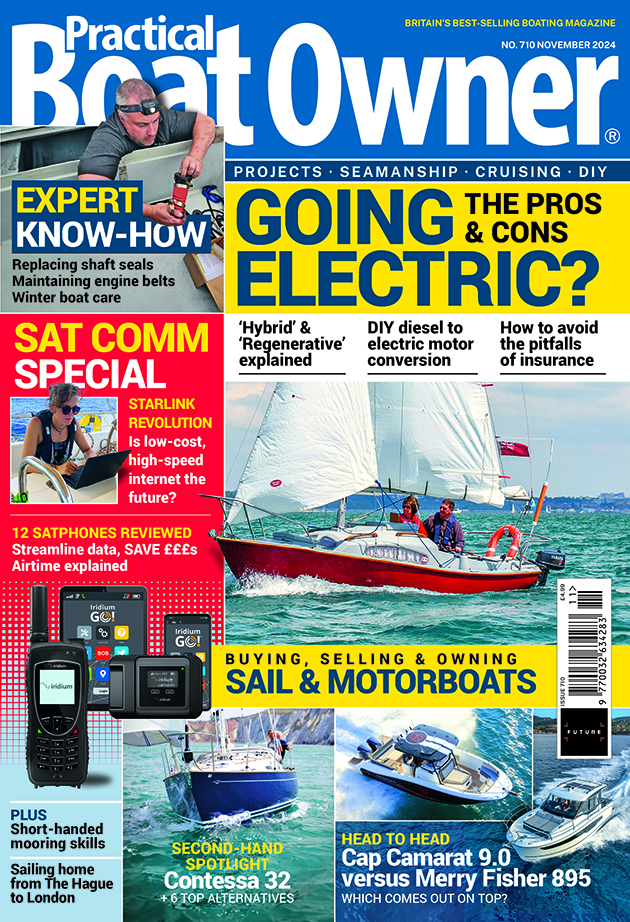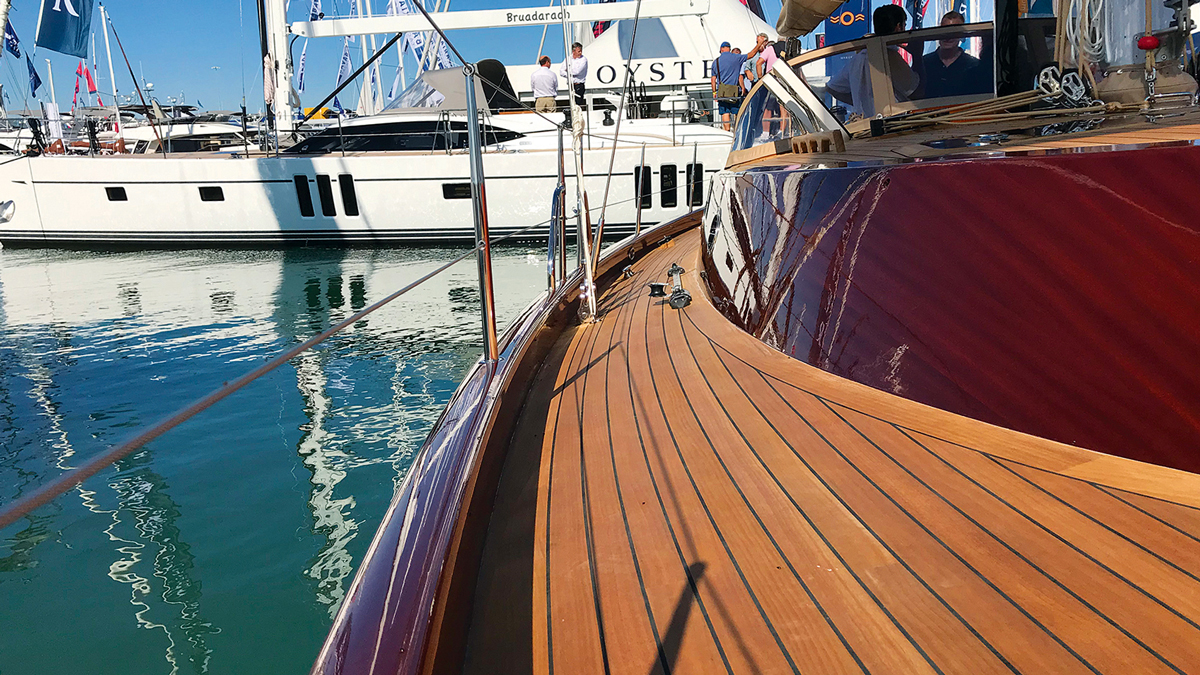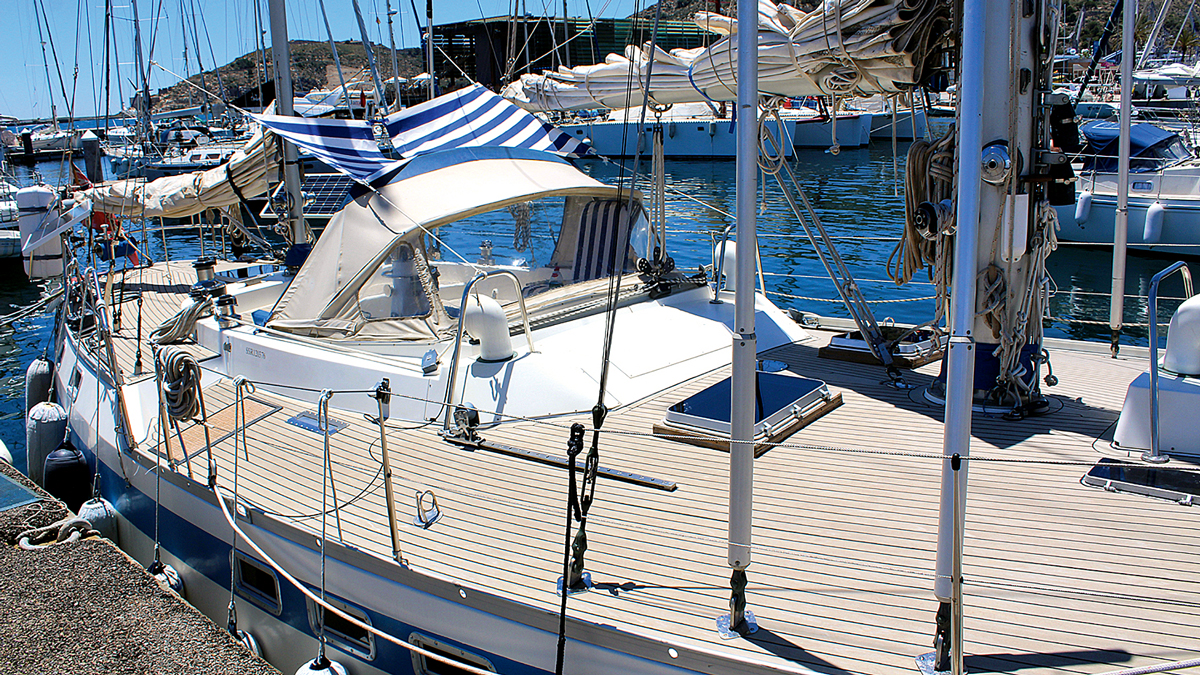Non-slip decks are vital for safe sailing, with a wide range of attractive, long-lived, and sustainable coverings available. Jake Kavanagh examines some old favourites and latest innovations
Tilted at 45° and wringing wet, a deck won’t provide the best grip underfoot, so for centuries sailors have always preferred non-slip decks that allow them a high degree of traction, whether shod or barefoot.
Historically, the favourites have been wooden planks, teak being the most prevalent in high-quality yachts.

Non-slip decks: There are some good alternatives to teak, such as iroko. Still offering a tight grain and hard surface, it can be used for classic decks. This picture shows the historic vessel Lively Lady receiving a new iroko deck, secured to a plywood base using West System epoxy…. Credit: Jake Kavanagh
But while many boat owners still enjoy the feel of real teak underfoot, they don’t want to be responsible for large gaps in the rain forests, so are seeking a more sustainable alternative.
Fortunately, big advances in composite technology and the heat treatment of softwoods have given much more choice.

….The finished result was seamed with Sikaflex 290DC, which made a tight seal between the planks. Credit: Jake Kavanagh
In ascending order of cost, we’ve looked at everything available for a boat owner seeking to improve their decks in a practical and aesthetically pleasing way.
Deck paint (single pack)
The simplest and quickest way to improve a deck is to paint it.
Several companies provide non-slip paints that are usually ‘single pack’ polyurethanes (one tin, no hardener required) with an added gripping agent.
Occasionally this agent is supplied in a separate bag, to be sprinkled in as the paint is stirred, or even scattered onto the surface before it dries.

Deck paint is easy to apply and can be used to cover a moulded non-skid as seen on this Corribee 21. Pulling up the masking tape when the paint is still wet gives a sharp edge. White can be used with different pigments for custom colours to match hull, sprayhood or sails. Credit: Jake Kavanagh
This allows you to adjust the amount of grip required and avoid a factory-added agent settling in the tin during storage.
Leading brands include International’s Interdeck (single pack), Nautix Grip (two-pack), Teamac’s Suregrip and Hempel’s Non-Slip Deck Coating.
In addition, several manufacturers supply their own sachets of additive, either finely dried and sifted sand or artificial beads known as ‘pearls’.
Jotun’s Anti-Skid Additive, for example, is made from aluminium oxide particles, similar to those found in leading brands of sandpaper.
While non-slip deck paints are available in the most popular colours (white, cream, light blue, brown and grey) it’s also possible to customise by adding a pigment to the white version.
A boat’s general colour scheme can be matched in this way.
If you want a custom colour, ask the paint supplier for the best way to do this, as they may have their own selection of compatible pigments.
Some can even mix the exact shade for you.
Specialised deck paints
Other chemistries are available for deck paint, which include alkyd rubber and acrylic formulations.
A good example is the acrylic-based KiwiGrip, which is painted on like a thick custard, making it good at filling small dents and depressions or hiding pre-moulded non-slip.

Non-slip decks: A KiwiGrip deck after three years. The owner reports the finish remains hard-wearing, is colour-fast, gives good traction and is easy to scrub clean. Credit: Jake Kavanagh
A textured roller is gently run over the paint before it dries to introduce a non-slip pattern.
Several colours and textures are available, and the paint can be machine-sanded flat at a later stage and reapplied.
As with any textured surface, dirt accumulates in the pores over time, but it is easy enough to clean.
EVA foam
A recent addition to the deck coverings sector is EVA foam, which has a major role in shoemaking as it is soft underfoot.
Many enterprising manufacturers have found that if you make a sandwich of two different colours, and then cut patterns through the top layer, the possibilities to customise are endless.

EVA foams have provided boat owners with a wide choice of custom colours and finishes. This two-layer Wasserdeck is being CNC cut with a unique design supplied by the customer. Credit: Jake Kavanagh
EVA foam decks are less heavy and much cheaper than the more robust vinyl versions, and while they don’t have the same longevity, they are easy to remove and reapply.
Many have a self-adhesive backing which makes fitting a straightforward DIY job.

Suppliers can assemble a deck as a series of panels based on accurate templates. The finished panels are attached to the deck using powerful adhesives. There’s a drying time window for repositioning, and care must be taken to avoid trapping air bubbles during application. Credit: Marinedeck 2000
Detachable mats are also available in the same design which can be placed over high-wear areas to make the underlying deck last longer.
Suppliers can work to a template from your decks or cockpit and introduce any designs you have in mind.
PVC, PU and ‘faux teak’
An area showing expansive growth is artificial teak made from polyurethane, currently with five main suppliers – Bolidt and Herculan in the Netherlands, Flexiteek and Permateek in the UK and Plasdeck in the US; several other smaller companies are operating successfully in the sector.
The products are available in a range of colours, textures, profiles and widths, leaving the boat owner rather spoilt for choice.
According to specialist fitter Elite Teak, decks that mimic a freshly scrubbed teak deck or the distinguished grey colour of a weathered one are the most popular choices.

Non-slip decks: Faux teak is usually made from hard-wearing and UV-stable vinyl and lends itself well to DIY assembly. This exhibit is from Flexiteek, showing what is possible, even on a small scale. Note the colour-matched trims. Credit: Jake Kavanagh
Several manufacturers can also supply greater thicknesses to be machined into colour-matched accessories.
With improving chemistries and additives, the types of planks, choice of colours and range of styles available are almost infinite.
The same material can be supplied as gunwale strips, cap rails, toe rails and even handles, so everything matches.
Unlike some of the earlier versions, the products are now extremely UV stable, and able to withstand the most common liquid spills.
A different grain can be introduced simply by sanding with a grit of choice.
Cork
Although it has long been used in marine applications, particularly in sound insulation, cork is now attracting more attention due to being highly sustainable and entirely recyclable.
As nature’s version of closed-cell foam, with some 40 million air-filled cells in each cubic centimetre, cork has properties that make it ideal as a decking material.

Non-slip decks: Cork can also be treated with a variety of coatings to extend its life and prevent it from weathering to grey in the same way as teak. It remains cool in hot weather and always has a good grip. Credit: Marinedeck 2000
These include elasticity, vibration resistance, minimal density and good insulation.
The magic component of the cell walls is suberin, a mixture of organic acids that prevent the passage of water or gasses.
Cork decking can be supplied as pre-made modules, plain sheets, single planks, or CNC-cut designs.
The material is also easy to cut and shape with a craft knife, making it ideal for DIY installations.

Cork is a sustainable, flexible and hard-wearing material that has millions of closed cells per cubic centimetre and can resist most liquid spills. It’s easy to cut and is often applied in thick planks to aid cabin insulation. Credit: Jake Kavanagh
Rubberised sheets
Favoured by commercial vessels and many deep-sea sailors, products such as Treadmaster and Trakmark combine natural materials such as cork and rubber into hard-wearing stick-down sheets.
The distinctive raised diamond pattern on the surface of some designs, while a little tough on bare feet, gives extraordinary grip in bad weather.
The sheets are easy to cut with a sharp blade and are usually held down with a two-pack epoxy, which bonds the mat firmly to the deck. Worn or sun-bleached mats can be revived with a colour-matched ‘Treadcote’ acrylic paint.
Tapes and pads
A range of self-adhesive tapes is also available from manufacturers like 3M which can be used in specific areas such as companionway steps.
With a basic choice of colours (including transparent), widths and textures, these tapes often prove an ideal solution.
Heat-treated wood
Emerging as a viable alternative to traditional teak decks is heat-treated softwood, sometimes called thermowood.
The process to remove (or replace) the water content in wood has been around in various forms for a while, with names such as Lignia Yacht (now part of the Netherlands-based Accys) and Kebony entering the marine market.
The shortage of natural teak has intensified demand.

Non-slip decks: Thermowood is quick-growing soft wood from sustainable forests that is specially treated to make it much harder wearing. The results can be used alongside other natural. Credit: Spirit Yachts
Apart from a lower price, thermowood has impeccable green credentials as the raw material is sourced from managed and fast-growing forests.
While some of the earlier types were for architectural applications, and lacked the resistance needed for a saltwater environment, the products have greatly improved.
The latest kiln treatments now create stable and machinable products, highly resistant to cracking, rot and fungi and with many of the aesthetic characteristics of natural teak.
With thermowoods meeting all sustainable forestry regulations (FSC), several major boatbuilders are already using these products, and other naturally treated woods, as hardwearing decking alternatives.
Reconstituted teak
Several manufacturers have developed a method to make fast-growing plantation teak appear more natural.
Plantation-grown teak tends to have a much wider grain, as the trees are not in natural competition with each other so have room to grow more quickly.

Non-slip decks: Reconstituted teak is indistinguishable from the tight grain of natural teak, with the added advantage that large baulks of timber can be created for machining into thick cap rails, handles and trims. Credit: Jake Kavanagh
Once harvested, the wood is sawn into very thin strips and then laminated with powerful resin glues to create timber that appears to have a tighter and more natural grain.
Large baulks can be made this way, and with the glue being the same density as the wood, these laminates are easy to machine into planks, cap rails and coamings.
The price is considerably less than natural teak and there are also no problems with sustainability.
The decks are just as hard-wearing and long-lived, and can be made in thicknesses that would prove extremely expensive using natural-sawn timber.
Natural teak
For the purist, natural teak is still available and is renowned for its tight grain and natural oils.
As with any material where demand outstrips supply, there have been issues with ensuring the source is from managed forests, with a current ban on any logs from Myanmar. (The geopolitical situation means illegal logging is used to finance the ongoing conflict there).
Teak can be successfully recycled, with some old teak cladding, furniture and classic decks being re-machined into thinner planks for reassembly into pre-shaped panels.

Non-slip decks: Natural teak is in short supply but many purists will have nothing else. Here, a Hallberg Rassy craftsman assembles a standard 6mm deck with planed timber from a certified source, although the company also offers a very realistic vinyl alternative. Credit: Jake Kavanagh
Many years ago, large parts of the London Underground were recycled this way.
For some projects, boatbuilders are opting for hardwood alternatives, such as iroko.
Available from managed forests, iroko has a tight grain and many properties of natural teak.
If you want the real thing, however, teak is still available, but be prepared to check its pedigree and brace yourself for a high price.
Temperature concerns when choosing non-slip decks
Under a relentless tropical sun, even light grey decks can become impossibly hot for bare feet.
A light-coloured deck will help to reflect some of the heat away, but these light colours can also be hard on the eyes, so some manufacturers produce decking that reduces glare.

Identical yachts – different destinations. The new Nautor Swan above will be based in Northern Europe, so has darker decks and black caulking….Credit: Jake Kavanagh
This attention to colour also extends to the planks themselves and the seams of caulking between them.
You may notice that many yachts intended for hot weather have seams of white or light grey, rather than the traditional black, to help reduce heat absorption.

….Her sister ship, right, is bound for the Mediterranean, so has paler decks and light-grey seams. Credit: Jake Kavanagh
There have even been experiments with additives into the fabric of artificial teak planks, aimed at reflecting some of the sun’s rays.
These make the planking lighter but have proved harder to clean over time.
Deck directory
Deck paints
- www.international-marine.com
- www.jotun.com
- www.nautix.com
- teamac.co.uk
- www.boatpaint.co.uk (KiwiGrip)
EVA Foams
- www.ultralonfoam.com
- info@wasser-dek.co.uk
- marinemat.net
- aquadeck.com
Vinyl decking
- www.herculan.com
- www.flexiteek.com
- www.bolidt.com
- www.api-spa.com
- www.plasdeck.com
- www.permateek.com
- www.nuteak.com
- www.lonseal.com
- www.esthec.com
Cork
Rubberised sheets
Natural or modified wood
How to apply KiwiGrip to your deck
Ben Meakins used KiwiGrip deck paint to refresh the non-slip on his boat’s decks last winter – but how well…
Teak alternatives: How to make your decks look as good as the real thing
However, according to a recent report by the Environment Investigation Agency, there are grave questions over the sustainability and sourcing…
How to fit Flexiteek decking: Swan 43 owner explains how he did it
When we bought Elisabeth, our Nautor’s Swan 43ft ketch, in 2006 she was already nearly 30 years old. At the…
How to lay EVA foam decking on your boat
With the eye-watering cost of teak, Andy Pag decides to lay bargain EVA foam decking in the cockpit of his…
Want to read more articles like 10 low-cost solutions for non-slip decks on boats?

A subscription to Practical Boat Owner magazine costs around 40% less than the cover price.
Print and digital editions are available through Magazines Direct – where you can also find the latest deals.
PBO is packed with information to help you get the most from boat ownership – whether sail or power.
-
-
-
- Take your DIY skills to the next level with trusted advice on boat maintenance and repairs
- Impartial in-depth gear reviews
- Practical cruising tips for making the most of your time afloat
-
-
Follow us on Facebook, Instagram, TikTok and Twitter








